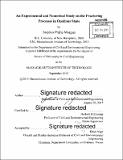An experimental and numerical study on the fracturing processes in Opalinus shale
Author(s)
Morgan, Stephen Philip
DownloadFull printable version (91.21Mb)
Other Contributors
Massachusetts Institute of Technology. Department of Civil and Environmental Engineering.
Advisor
Herbert H Einstein.
Terms of use
Metadata
Show full item recordAbstract
The extraction of hydrocarbons from unconventional oil and gas reservoirs relies on a detailed understanding of the fracture processes in shale. Also, underground structures designed for nuclear waste repositories are typically constructed in shale due to its characteristic low permeability. To understand the behavior of shale it is important to know how cracks initiate, propagate and coalesce. Although there have been many studies on the cracking processes in rock, cracking in shale is not well understood mainly due to its anisotropy, which is caused by naturally formed bedding planes. Natural bedding planes are weak zones along which cracks can initiate and propagate. As a consequence, the effect of bedding planes on crack initiation and propagation has not been captured well in previous models. A series of unconfined compression tests were conducted on Opalinus shale extracted from the Mont Terri underground rock laboratory in Switzerland. These tests consisted of prismatic Opalinus shale specimens with two pre-existing flaws and various bedding plane orientations. High speed and high resolution imagery were used to capture crack initiation, -propagation and -coalescence between the flaw pairs. It was found that as the bedding plane angle increased, cracks initiating at the flaw tips tended to propagate more frequently along the bedding planes. FROCK, a model based on the Displacement Discontinuity Method (a type of Boundary Element Model) developed at MIT, was modified to incorporate the effect of bedding planes on the crack propagation patterns. A discontinuous critical strain criterion was implemented into the model, showing acceptable predictions of the crack initiation, -propagation pattern and -mode (tensile/shear) when compared to the experimental results. The results from this thesis can be used to further improve predictive crack propagation models in anisotropic rock.
Description
Thesis: Ph. D., Massachusetts Institute of Technology, Department of Civil and Environmental Engineering, 2015. Cataloged from PDF version of thesis. Includes bibliographical references (pages 315-327).
Date issued
2015Department
Massachusetts Institute of Technology. Department of Civil and Environmental EngineeringPublisher
Massachusetts Institute of Technology
Keywords
Civil and Environmental Engineering.